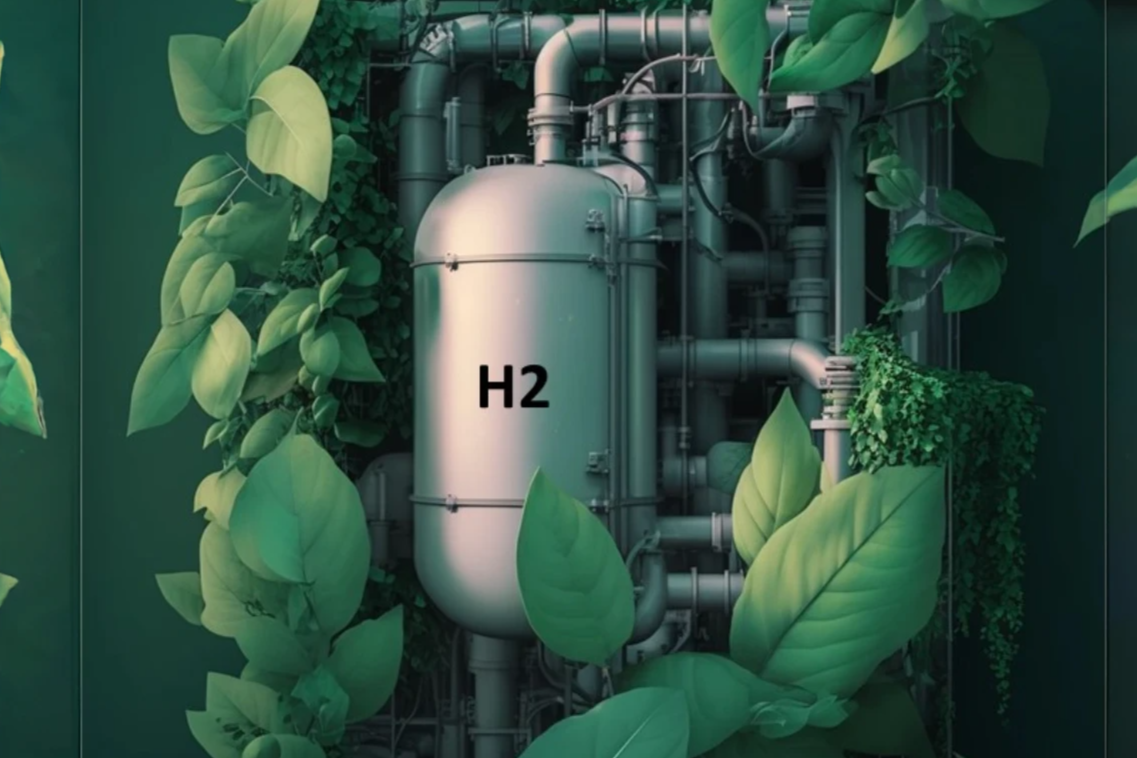The Promise of Green Hydrogen: The Future of the Global Energy Transition?

Share this Post
Green hydrogen is a zero-emission alternative to fossil fuels, produced by using renewable electricity to split hydrogen from water molecules, with water vapor being the only waste product. It has the potential to decarbonize hard-to-abate sectors such as heavy industry, long-haul aviation, and transportation. However, challenges remain, including the high cost of production, the need for infrastructure adaptation, and the need for scale-up of green hydrogen plants. Despite these challenges, green hydrogen has significant potential to play a key role in the global green transition, as it can be stored for future use, unlike renewable electricity. Hydrogen can also be produced with nuclear and fossil fuels with Carbon Capture, Utilization and Storage (CCUS) for low-emission hydrogen solutions, or blue hydrogen.
The Promise of Green Hydrogen
The decarbonization of all sectors of the global economy presents a significant challenge, particularly in the hard-to-abate sectors such as heavy industry, long-haul aviation, and transportation, where direct electricity usage is not feasible. Green hydrogen, produced through the application of renewable electricity, offers a widely available alternative to fossil fuels and holds immense potential to play a pivotal role in the global transition towards sustainable energy. As the most plentiful element in the universe, hydrogen offers an available energy source that is clean and versatile and can help reduce our dependence on fossil fuels and accelerate the shift towards a cleaner, greener future.
What is Green Hydrogen?
Hydrogen, a colorless and odorless gaseous substance, is an energy carrier that can deliver or store enormous amounts of energy, for example to be used in fuel cells to generate electricity. Today, its widely used in petroleum refining, fertilizer production, treating metals and processing foods. Hydrogen can also be used in transportation: hydrogen internal combustion engine vehicles (HICEV) use a modified version of the traditional gasoline-powered internal combustion engine while electric vehicles use a fuel cell, often in combination with a battery, to power the electric engine.
However, each year 75 million tons of hydrogen is produced around the world, by far most of this in a process that uses fossil fuels such as natural gas and coal, resulting in significant amounts of CO2 emissions along the way. According to the International Energy Agency (IEA), hydrogen produced at present is almost entirely using natural gas and coal. Its production, mainly for the chemicals and refining industries, is responsible for 830 million tons of CO2 emissions per year.
Green hydrogen, on the other hand, is produced by applying renewable electricity such as wind energy to power an electrolyzer that splits the hydrogen from the water molecules, resulting in zero emissions. The only waste product is water vapor. And unlike most other forms of renewable electricity, green hydrogen can be stored for future use.
Low-emission hydrogen production, it should be noted, can also be produced with nuclear and fossil fuels such as natural gas where emissions have been captured using Carbon, Capture, Utilization and Storage (CCUS) to separate the CO2 from the hydrogen. Although blue hydrogen using CCUS is seen playing an important role in scaling up low-emission hydrogen volumes in short to medium term and help drive the development of both technologies and infrastructure, green hydrogen is a zero-carbon solution and is considered the endgame.
The Potential of Green Hydrogen
The advent of green hydrogen on a large scale will render it possible and environmentally expedient to expand hydrogen’s use beyond current applications. Green hydrogen has the potential to significantly reduce carbon emissions in a range of sectors, including long-haul transport, steel and iron, cement, and chemicals. Long-haul transport is responsible for approximately 7% of global CO2 emissions, making it a difficult-to-abate sector. By using green hydrogen as a fuel source, it is possible to reduce emissions from long-haul transport, which relies heavily on fossil fuels.
The cement industry is another big CO2 producer, accounting for about 7% of global CO2 emissions, largely due to the production of cement clinker, a key ingredient in cement. Production of cement clinker requires high temperatures and emits large amounts of carbon. Using green hydrogen as a fuel source in the production of cement would lead to a reduction of carbon emissions in this sector.
The chemical industry is also a significant contributor to carbon emissions, with the production of chemicals responsible for approximately 10% of global carbon emissions. Green hydrogen can be used as a sustainable fuel and as sustainable feedstock, this mostly when producing ammonia, and can then help significantly reduce emissions from the chemical industry.
Today, the iron and steel industries are responsible for about 4% of anthropogenic CO2 emissions in Europe and 9% worldwide, largely due to their massive use of coal. Steel production, for example, requires large amounts of coal to first turn iron ore into iron using blast furnaces and then to turn the iron into steel in a basic oxygen converter process. By replacing coal with green hydrogen, the industry can largely be decarbonized, reducing the emissions associated with steel production.
High costs and infrastructure
The transition to green hydrogen is crucial for achieving carbon-neutral industries, but there are challenges to overcome, including the high cost of production. Currently, replacing coal with green hydrogen would increase the price of a ton of steel by approximately one third. There is reason, however, for optimism. Costs are expected to decrease as renewable electricity costs decline and carbon-emission pricing drives up the cost of coal usage.
Moreover, larger-scale production of green hydrogen and optimization of hydrogen-based steel production processes can lead to efficiency gains and cost reduction, as per a European Parliament briefing paper on the potential of hydrogen for decarbonizing steel production. The paper notes that green hydrogen can completely decarbonize the production processes in steel production though this requires more pilot plants being established and much greater production quantities of green hydrogen.
Technological readiness is still at a low level and needs to be proven at scale. Scaling up green hydrogen plants is therefore critical to achieving price parity with hydrogen produced from fossil fuels. According to the International Renewable Energy Agency (IRENA), increasing plant size from 1MW to 20MW can reduce costs by more than a third.
IRENA also suggests that stable, long-term policy frameworks and key international climate goals are needed to support development and deployment at scale and will help drive rapid cost reductions for green hydrogen. The trajectory required to limit global warming to 1.5C could make electrolyzers an estimated 40% cheaper by 2030, according to IRENA.
Adapting the current gas transport infrastructure to accommodate green hydrogen is also essential. Although significant reconfiguration and adaptation will be necessary, it is expected that existing gas pipelines can transport green hydrogen, reducing the amount of costly infrastructure required for a new green hydrogen transmission network. According to the International Energy Agency (IEA), repurposing natural gas pipelines for the transport of green hydrogen can reduce investment costs by 50%-80% relative to developing new pipelines. However, the IEA cautions that practical experience is limited.
Global trends
According to the International Energy Agency (IEA), in 2021, hydrogen demand worldwide reached 94 million metric tons (Mt), supplied by less than 1 Mt of low-emission hydrogen, produced mostly from plants using fossil fuels with CCUS. However, the IEA estimates that low-emission hydrogen production could reach 16-24 Mt per year by 2030, with 9-14 Mt from electrolysis, requiring an installed electrolyzer capacity of 134-240 GW by 2030. Still, this falls short of the 34 Mt of low-emission hydrogen production per year by 2030 needed to meet international climate pledges and falls even further from the approximately 100 Mt needed by 2030 to reach net-zero emissions globally by 2050.
Areas rich in renewable energy resources are best suited for green hydrogen production globally. Sub-Saharan Africa, with its vast non-arable land, ample sun, and wind resources has the highest potential, with a 2022 Statista study suggesting that the region could produce up to 1,923 exajoules of green hydrogen at less than USD 2 per kilogram. In contrast, even under the most optimistic scenario, Europe, which already has a significant number of green hydrogen plants, could only produce up to 343 exajoules annually.
In addition to the benefits at the global level, the development of a green hydrogen economy in Africa will help address many of the continent’s challenges, such as energy poverty, and support sustainable development without harming human health or the environment. IRENA predicts that Africa’s energy transition could generate 26 million jobs by 2050. The United Nations reports that although the African continent contributes less than 4% to global greenhouse gas emissions, many African countries are looking towards green hydrogen to sustainably harness existing resources, meet growing energy demand, and reduce reliance on fossil fuels. Egypt and Zambia have already installed over 100 MW of electrolyzers, and according to the World Bank, there are plans to build further green hydrogen projects in Egypt, Mauritania, Morocco, Namibia, and South Africa. The H2Atlas-Africa initiative, a joint effort between the German government and Sub-Saharan African partners, aims to produce 165,000 TWh per year in West Africa through multiple projects.
Australia has vast potential for renewable energy, particularly in solar photovoltaic, and it has the highest number of green hydrogen plants globally, with 96 facilities as of 2022, as per Statista. The country is anticipated to be among those with the lowest levelized costs for green hydrogen production by 2050, owing to its abundance of solar and wind resources.
China, already the world’s leading producer of green hydrogen with roughly one-third of global production, is expected to establish a 260 MW facility by mid-2023, in addition to the existing 150 MW alkaline electrolyzer, which is considered to be the largest in the world. Sinopec, the state-controlled Chinese company, is building a green hydrogen plant in Kuga city in the Xinjiang region, fueled by a 300 MW solar power station, with an anticipated annual production capacity of 20,000 metric ton.
In Europe, numerous large-scale green hydrogen projects are in the works, such as HyDeal Ambition, a platform comprising 30 firms that cover the complete green hydrogen value chain, including solar power generation, electrolyzer production, gas transmission and storage, as well as industrial applications in steel, chemicals, and power. HyDeal Ambitions network, which spans across Western Europe from Spain to France and Germany, is aiming to generate 3.6 million metric ton of green hydrogen by 2030, with 95 GW of solar and 67 GW of electrolyzer capacity.
Two projects are planned for the Port of Rotterdam. Shell recently signed a contract to construct a 200 MW electrolyzer that will produce up to 60,000 kilograms of green renewable hydrogen per day. Renewable electricity will be sourced from the Hollandse Kust offshore wind farm. Meanwhile, the H2-Fifty Project in the Port of Rotterdam, a joint venture between BP and HyCC, will have a 250 MW capacity, produce 20,000-30,000 tons of green hydrogen, and reduce up to 270,000 metric tons of CO2 per year.
In Denmark, the HySynergy project by Everfuel aims to establish a large-scale green hydrogen production and storage facility, with a capacity of 300MW by 2025 and 1GW by 2030. Germany will expand its capacity to 100MW with the REFHYNE2 project. And the EU’s REPowerEU plan, released in May 2022, aims to both produce and import 10 million metric ton of green hydrogen by 2030, as part of its target to be climate-neutral by 2050.
Outlook: The Future of Green Hydrogen
Green hydrogen has the potential to play a vital role in the global transition towards sustainable energy, particularly in hard-to-abate sectors such as heavy industry and transportation. Scaling up green hydrogen plants and optimizing hydrogen-based steel production processes can drive rapid cost reduction, but meanwhile, production costs remain a challenge, as does the need for infrastructure adaptation. Despite these challenges, the promise of green hydrogen is significant, and its potential to reduce carbon emissions in various sectors makes it a promising alternative to fossil fuels.
Further readings:
Defiance ETFs introduces you to the three companies at the forefront of green hydrogen production.
For the World Economic Forum, Johnny Wood looks at the countries that could become the world’s hydrogen superpowers.
This Bloomberg’s article explores the rapid growth of China’s capacity to manufacture electrolyzers.
For Financial Times, Benjamin Parkin delves into India’s big hopes for green hydrogen.
Researchers from Agora Energiewende analyze how cooperation on hydrogen industrial clusters between China and Europe could help move the clean energy transition agenda forward.
For Reuters, Gavin Maguire discusses how realistic a hydrogen-powered economy is.
The opinions expressed in this text are solely that of the author/s and do not necessarily reflect the views of the Israel Public Policy Institute (IPPI) and/or its partners.
Share this Post

What is Digital Constitutionalism? A View from Europe
The Rise of European Digital Constitutionalism In the last twenty years, the policy of the European Union in…

Sustainable Finance Explained: Concepts, Advantages, and Practical Implementations
Sustainable finance represents a transformative shift in how financial services contribute to a greener, more equitable, and sustainable future. Unlike…

Bridging Environmental Frameworks Across Borders: Overview of the European Union’s Green Taxonomy and its Relevance beyond Europe
The European Union’s “Green Deal,” initiated by the 2019-elected EU Commission, stands as a symbol of Europe’s resolute…
